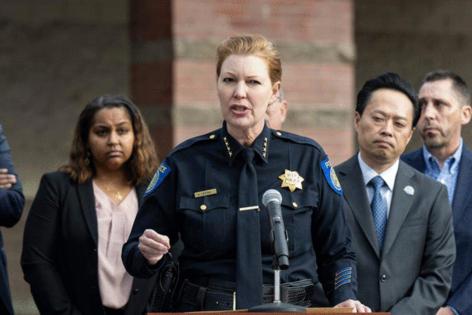Will Sacramento keep controversial gunshot-detection tech? Budget may be an issue
Published in News & Features
SACRAMENTO, Calif. – As Sacramento grapples with its multimillion-dollar structural deficit, officials are considering whether to commit money to a controversial gunfire-detection technology.
For more than a decade, Sacramento has contracted and spent millions on ShotSpotter — a system that detects and locates suspected shooting incidents. Roughly 180 cities across the U.S. use this technology, according to California-based SoundThinking, which sells the system.
Many law enforcement agencies have praised the tool for cutting response times to gunfire and getting aid to victims faster. But critics say ShotSpotter is costly, prone to false alerts, disproportionately affects communities of color and has no effect on reducing gun violence.
That debate has prompted several major cities, including Chicago, Baton Rouge, Seattle and Houston, to end their contracts in recent years.
Whether Sacramento will join those cities remains uncertain. The city last renewed its contract in 2020 amid criticism of police brutality and a national outcry to defund law enforcement budgets.
Since then, a growing body of research has cast doubt on the effectiveness of ShotSpotter. A 2023 study from Northeastern University found the technology did not reduce crime, though it helped police decrease their response times to shootings.
“For the price that you’re paying, you really have to start to take a hard look,” said Terrance Hinton, a professor of sociology at the Ohio State University. “If you look around the United States, a number of cities have decided that this is not worth the price, and they’re moving away from it.”
For Sacramento, the question of cost is particularly noteworthy given the city remains in a structural budget deficit that could reach up to $90 million by 2030, according to staff projections.
The technology costs the city roughly $531,000 per year to maintain. But associated labor costs have added up to another $2.4 million annually in previous years, according to data from the Sacramento Community Police Review Commission.
Sacramento’s last contract with ShotSpotter expired in June, but the system remains operational as part of the city’s “public safety efforts,” said Police Department spokesperson Sgt. Dan Wiseman.
Last month, city officials appeared ready to approve a new five-year, $2.6 million contract by placing it on the City Council’s consent calendar agenda — a method typically reserved for non-controversial items. However, Interim City Manager Leyne Milstein removed the proposal before the vote, with city spokesperson Jennifer Singer later saying that the move was to add an “out clause” to the contract.
The department and city have not provided a date for when the contract will return to the council.
How ShotSpotter works
ShotSpotter launched in the late 1990s to primarily help law enforcement respond more quickly to gunfire incidents. Other purposes include aiding officers find bullet casings, locate surveillance camera footage and identify witnesses, said Melissa Dooher, a senior director of forensics and litigation support at SoundThinking.
The technology relies on an array of audio sensors, which pick up outdoor noise processed through the system’s algorithm. These sensors create a “visual graph” with a roughly 25-meter “halo” around the estimated location whenever there’s sounds consistent with gunfire, Dooher said.
A human operator with the company then reviews noises and decides whether to notify police. Per its contract, Dooher said, notifications must reach police within a minute of the gunfire.
“Our highest purpose is to save lives or to decrease the severity of injuries that people do sustain,” Dooher said.
By 2015, the company held contracts with nearly 100 cities. That same year, Sacramento placed its first ShotSpotter in north Sacramento at an annual cost of roughly $150,000.
“In an ongoing effort to reduce violent crimes, the Sacramento Police Department recommends the implementation of a gunshot detection monitoring system, on a trial basis, that will serve to reduce response times,” said a staff report from February 2015.
Within three years, citing its success, the city added systems at two more locations. One was placed in south Sacramento and the other in east Sacramento.
The city approved a five-year contract for all three in 2020, despite calls from activists to redirect the money.
“One of the most insidious public health issues is gun violence,” former Mayor Darrell Steinberg told The Sacramento Bee at the time. “Any tool that gets guns out of the hands of the people shooting and killing others is a good thing.”
Mixed results nationwide
Since Sacramento’s last renewal, concerns about ShotSpotter have mounted across the nation.
In 2019, Eric Piza, professor of criminology and criminal justice and director of Crime Analysis Initiatives at Northeastern, set out to study the technology’s effectiveness in Kansas City and Chicago.
Using 15 years of crime data, Piza found that ShotSpotter helped police respond a “little faster” compared to shootings reported through 911. Police also collected more ballistic evidence — bullet shell casings, bullet fragments, projectiles — more often.
But the findings when it came to “big outcome factors,” were also clear, Piza said. In both cities, ShotSpotter did not reduce shootings or increase the likelihood that shootings would be solved.
“ShotSpotter does not have an effective track record when it comes to preventing gun violence,” Piza said.
Other findings have furthered concerns with the technology.
In 2015, the ACLU raised concerns that ShotSpotter’s “sensors constantly record audio.” An audit of the New York City Police Department last year found that only 13% of ShotSpotter alerts throughout the city were confirmed shootings. And a story by Wired revealed that the sensor locations are predominantly placed in low-income communities of color, raising concerns about overpolicing.
“It has led a number of cities to looking at: Is it really worth the cost?” Hinton said.
In 2024, SoundThinking reported having 85 contract renewals and six non-renewals.
The Sacramento County Sheriff’s Office temporarily ended its contract with ShotSpotter in 2019, according to previous Bee reporting. The agency has since resigned with the system and placed it at four locations in the county, said Sgt. Amar Gandhi, a spokesperson for the Sheriff’s Office.
“What is most important to understand is that more customers have expanded or renewed their coverage in the last year alone than have not renewed in the entire last decade,” SoundThinking said in a statement.
Does the tech work in Sacramento?
In Sacramento, the Community Police Review Commission has gathered its own data pointing to the ineffectiveness of the technology. Between 2015 and 2022, the city’s commission found only 4% of ShotSpotter alerts led to arrests and 8.5% resulted in firearms seized.
The commission, citing costs and effectiveness, has recommended that Sacramento cut its ties with the company since 2023. It cited additional labor costs of about $2.4 million per year when the city had a dedicated ShotSpotter team of 12 officers.
“ShotSpotter is notorious for being just unreliable, ineffective in actually reducing gun violence, or much less actually preventing it,” said Keyan Bliss, a former Police Review commissioner who helped gather the data.
Future costs of the technology remain uncertain should the city decide to renew the contract. The department has reassigned all the officers previously on the ShotSpotter team and could not “say for certain” what the program’s current labor costs are, Wiseman said.
Wiseman also said the Police Department was “not in a position to comment in detail,” citing the upcoming council vote when asked about the concerns and research on the technology.
“We recognize there are differing perspectives on the program and understand the importance of transparency, but it’s not appropriate to speak to data or research we haven’t independently verified,” Wiseman said in a written statement.
Piza encouraged cities weighing to renew their ShotSpotter contracts to analyze their own data and decide what they want the tool to accomplish. If the goal is to prevent gun violence, cities may find their money better spent elsewhere.
“Too many cities adopt technology, not just Shot Spotter, but technology, just generally speaking, without putting any resources behind actually evaluating whether or not they’re getting their return on investment,” Piza said.
____
©2025 The Sacramento Bee. Visit at sacbee.com. Distributed by Tribune Content Agency, LLC.







Comments